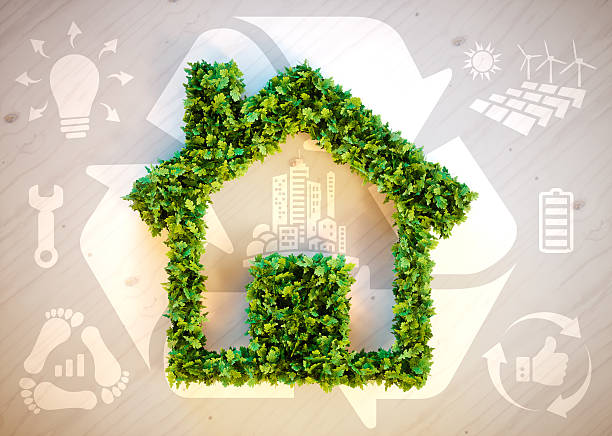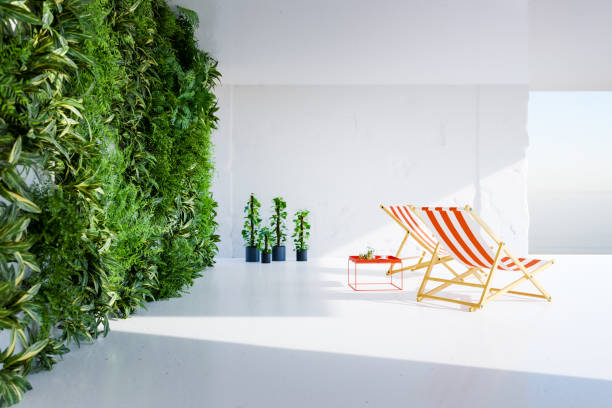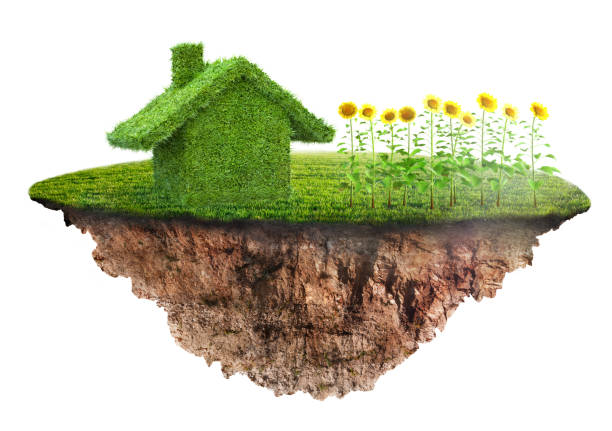With the advancement of new technologies, more people are considering how their actions impact the world around them. As a result of this awareness, there is an increase in eco-friendly houses.
The question is, what exactly is an eco-friendly house, and what qualities should it have? This post will reveal everything you need to know about environmentally friendly homes.
What is an Eco-Friendly House?
An eco-friendly house is a building that is designed and built with materials and appliances that are friendly to the planet to minimize carbon footprint and ensure environmental conservation.
However, being eco-friendly in your house does not necessarily mean that you have solar panels on your roof (although this does count) or that you use twice as much water in the toilet.
There are many ways to reduce energy consumption, from using energy-efficient lights and fixtures to painting your house with soy paint or installing large windows to let in more natural light.
The cost of running a new house is 63% less than that of an older home. As a result of the high-quality materials used, along with proper insulation, our buildings are more energy-efficient.
10 Features of an Eco-Friendly House

Similar to their definition, eco-friendly houses differ in their key features. There will be some differences between each home, or project, and therefore different features or requirements will apply.
There are several common features, including:
1. Adequate insulation
Compared to older-built homes, eco-friendly houses will have much more insulation. Insulation saves energy and helps the environment by reducing the need to turn on the heating.
In general, newer, eco-friendly homes have insulation that naturally warms the home and prevents heat from escaping. This saves money on household bills.
2. Using renewable energy
To reduce the huge environmental impact of fossil fuels, you will want an eco-friendly house that uses renewable energy sources.
For efficient and cost-effective energy generation, eco homes often feature heat pumps and biomass boilers. Therefore, this is a worthy consideration.
3. Using solar panels
Solar panels provide electricity and hot water to most eco-friendly homes, which can then be used throughout the house.
When you use solar energy, your energy consumption does not contribute to global warming since greenhouse gases are avoided.
To conserve as much solar energy as possible, environmentally friendly houses can feature solar panels on their roofs.
Property owners often have this innovative feature installed, which can effectively reduce your carbon footprint by 80% in one year!
4. Water-saving systems
You can use natural rainwater for your home when you build an eco-friendly house because it will be equipped with efficient systems for collecting, storing, and reusing water.
The rainwater that falls on your roof, for example, can be collected through rainwater harvesting systems. A water bank or rain trap is used to store this water underground, or aboveground, for example in water butts.
5. Reclaimed wood
Developing eco-friendly homes requires the use of the right materials. Many of these properties will be constructed using wood sourced from sustainable sources, like farmhouses, forests, old factories, and homes.
To minimize deforestation, you will not find typical carbon-costly materials in ‘green’ homes/buildings. Utilizing reclaimed wood for countertops, flooring, and wall panels reduces the need to source new materials.
By reducing landfill waste, reclaimed wood also benefits the environment. The fact that reclaimed wood comes from older, mature trees makes it more durable than new hardwoods, which is why it is used. An eco-friendly property can be recognized by its interior materials.
6. Effective ventilation systems
House ventilation systems called MVHRs (Mechanical Ventilation with Heat Recovery) are available for eco-friendly homes. The system is responsible for extracting and supplying air throughout your home.
You won’t find increased ventilation in older homes, mainly because older homes were built many years ago, without considering the environment. New eco homes are ideal for increased ventilation.
7. Using smart technology
Energy consumption can be reduced significantly in homes with smart technology installed. A smart lighting system and a smart thermostat are common features in eco-friendly homes. By keeping your house warmer naturally, you will use less energy in the long run, which contributes to a greener environment.
8. Reduced energy usage
Any building project should consider energy efficiency as a key environmental consideration. Buildings are affected by environmental changes in every aspect, from air duct sealing to using renewable energy for cooling and heating systems.
Energy-efficient lights, solar panels, timer-adjusted street lights, and electricity generated by renewable sources, such as tidal and hydroelectric power, are among the best energy-saving techniques in eco-friendly houses.
9. Proper waste management
The main goals of an eco-friendly home are to reduce landfill waste and to reduce the carbon footprint of the building. A building’s carbon footprint is reduced by treating wastewater on-site rather than sending it to sewage plants.
As a result of these houses’ efficient waste management systems, we can compost on-site and separate wet and dry waste, reducing the negative environmental impacts even further.
10. Encourages healthy living
In eco-friendly houses, beautiful landscaping puts you in a good mood and makes you feel free because they are built to withstand pollution and contamination.
As well as providing you with healthy lifestyle amenities, they provide vibrant gardens, verdant parks, and natural running trails where you can revitalize unnoticed by the frantic city streets.
You will be able to focus better on these improvements because they will improve your mental, physical, and spiritual energy.
Materials for an Eco-Friendly House

A variety of reasons, including price and accessibility, have contributed to the rise of eco-friendly building materials.
In addition to solar panels, slate, timber, natural stone, LED lighting, and less of a focus on uPVC and other plastics, materials can vary based on the scope of the project.
The following three factors might be useful to consider when choosing materials for your eco-friendly home project:
-
- The ability to recycle/reuse
-
- Elements that decompose naturally
-
- Geographical location
Location continues to be an important factor as environmentally friendly building materials are increasingly sourced locally. Consider your location and what might be nearby, even if it isn’t always possible.
Reasons to Build an Eco-Friendly Home?
In addition to just being cool, building an environmentally friendly home is a great idea for several other reasons as well. For example:
-
- It reduces your carbon footprint
Less carbon is released into the atmosphere as a result of energy and gas efficiency. A sustainable build can help you avoid becoming a part of the 40% of carbon emissions that come from the construction industry.
-
- Saves money and time
Construction of a home takes time and money, which we could all use more of. To reduce shipping costs and help the local economy, consider shopping locally for materials.
If you are building a green home, you may want to consider a green home kit that comes with prefabricated green building options.
-
- Protects your health
Many homes are constructed using materials that are not the best for humans. Would you eat unhealthy food if you didn’t live in an unhealthy house for 30 years?
Ways to Make My Home Eco-Friendly?

Some people are not interested in building an eco-friendly home from scratch. Your current home can still help you reduce your carbon footprint if you take steps to do so.
The average energy bill can be reduced by 20% to 60% by making eco-friendly changes. Apartment Therapy offers a few tips for making your home and the earth best friends, from the simple to the complicated:
-
- Select the right wood: Utilize reclaimed wood when possible and look for sustainable wood furniture.
-
- Use proper fabrics: Natural fibers such as linen and hemp, as well as organic cotton and humanely treated wool, should be looked for. Synthetics made from recycled polyester are a good choice.
-
- Don’t kill trees: Switch to cloth towels instead of paper towels.
-
- Switch lights: In comparison to incandescent bulbs, LEDs have a lower environmental impact.
-
- Recycle: Keep your leftover materials and scraps from your projects so you can reuse them in the future.
-
- Replace chemical products: In today’s world, finding natural cleaners is as easy as grabbing a coffee at Starbucks. Consider using all-natural cleaners instead of chemical-filled ones.
-
- Make the air cleaner: Purifying plants and air purifiers are good investments.
-
- Don’t forget to recycle: You can enhance your recycling by understanding your town’s rules.
-
- Choose eco-friendly paints: The most common type of wall paint contains volatile organic compounds (VOCs) that facilitate the spreading of the paint. There are also some harmful chemicals in VOCs.
-
- Keep warm: You’ll save energy if you don’t have to turn on the heat as much, so grab an extra blanket and your favorite pet.
Types of Eco-Friendly Houses

1. Bioclimatic Homes
Eco-friendly homes that take into account their surroundings are referred to as bioclimatic homes. To build them, they use natural resources from the area where they are located.
A bioclimatic home must be built in an appropriate location and geographical position to work with the region’s characteristics.
2. Passive Homes
Solar power is one factor in passive homes, but there are many others. It is the goal of passive houses to be constructed in a way that allows for efficient energy use, so that residents do not require outside sources of power, such as the grid or utilities. Designed according to Passive House Institute standards, Passive Houses are certified.
3. Wooden Homes
Construction of homes made of wood is more environmentally friendly and more economical than construction of homes made of bricks, cement, and mortar.
The use of wood has only positive environmental impacts and benefits since it is a natural component of the environment.
In structures like these, natural materials can be recycled and reused instead of being wastefully disposed of in landfills where they will never decompose.
4. Tiny Homes
Because of their widespread promotion in the media, tiny houses are becoming increasingly popular. Simplicity is emphasized in tiny houses, which is both challenging and rewarding.
Most of the time, we tend to overcomplicate things instead of simplifying them in life, so we find that the small things in life are more satisfying than the big ones.
The benefits of living in a tiny house include saving money, saving space, and wasting less energy as well.
Conclusion
Increasingly, people are concerned about the environment, and they are looking for ways to reduce their carbon footprints while improving their homes and lives.
The benefits of living in an eco-friendly home are making them more popular. When it comes to reducing your environmental impact, eco-friendly homes are a great choice.
FAQs
What is an Eco-Friendly House?
An eco-friendly house, also known as a green or sustainable home, is a dwelling designed and constructed to minimize its impact on the environment. It aims to reduce energy consumption, waste, and carbon emissions while promoting renewable resources and sustainable building practices.
Why Should I Consider an Eco-Friendly House?
Opting for an eco-friendly house can benefit both the environment and your wallet. These homes are energy-efficient, which leads to lower utility bills, and they help reduce your carbon footprint, contributing to a healthier planet.
What Are Some Key Features of Eco-Friendly Homes?
Eco-friendly houses incorporate solar panels, energy-efficient appliances, proper insulation, sustainable materials, rainwater harvesting, and advanced HVAC systems to reduce energy consumption and waste.
How Can I Make My Existing House More Eco-Friendly?
You can have an eco-friendly house by upgrading insulation, switching to energy-efficient lighting, using smart thermostats, and retrofitting your home with solar panels. These changes can significantly reduce energy usage.
What Are the Benefits of Solar Panels in an Eco-Friendly House?
Solar panels harness the power of the sun to generate clean energy. They can reduce your electricity bills, increase your home’s value, and help reduce greenhouse gas emissions.
What Is Sustainable Landscaping, and Why is it Important?
Sustainable landscaping involves using native plants, reducing water usage, and creating a more eco-friendly outdoor space. It helps conserve water and promotes biodiversity in your garden.
How Do Eco-Friendly Houses Contribute to Energy Efficiency?
Eco-friendly houses prioritize energy efficiency through features like double-glazed windows, proper insulation, and energy-efficient appliances. This leads to reduced energy consumption and lower energy bills.
Are There Financial Incentives for Eco-Friendly Home Upgrades?
Yes, many governments and organizations offer financial incentives, tax credits, and rebates for eco-friendly home upgrades. These incentives can help offset the initial costs of green improvements.
How Can I Reduce Water Consumption in My Eco-Friendly House?
To reduce water consumption, consider installing low-flow fixtures, collecting rainwater for irrigation, and choosing water-efficient appliances. These changes conserve water and lower your water bills.
Can an Eco-Friendly House Increase My Property’s Value?
Yes, eco-friendly features can increase your property’s value. Energy-efficient upgrades and sustainable practices are attractive to eco-conscious buyers and can make your home more desirable in the real estate market.
What’s the Environmental Impact of Eco-Friendly Houses?
Eco-friendly houses have a positive environmental impact by reducing carbon emissions, conserving resources, and promoting sustainable living practices. They play a crucial role in mitigating climate change.
How Can I Find Eco-Friendly Home Builders and Contractors?
To find eco-friendly home builders and contractors, search online directories, read reviews, and ask for recommendations from eco-conscious friends and neighbors. Ensure they have experience in sustainable construction.
What Are the Top Trends in Eco-Friendly Home Design?
Some current trends in eco-friendly home design include passive solar design, modular construction, and the use of recycled and reclaimed materials. These trends prioritize environmental sustainability and innovation.
What Role Do Smart Home Technologies Play in Eco-Friendly Houses?
Smart home technologies can enhance the eco-friendliness of your house by optimizing energy use, allowing remote monitoring and control of energy systems, and reducing energy waste.
How Can I Start the Journey Toward an Eco-Friendly House?
Begin your journey towards an eco-friendly house by conducting an energy audit, setting sustainability goals, and gradually making green upgrades to your home. Consult with experts for guidance.







